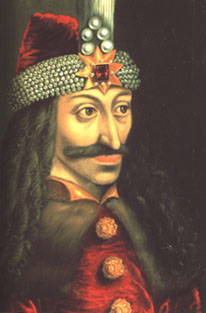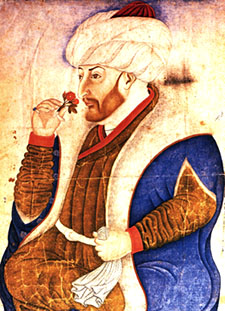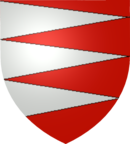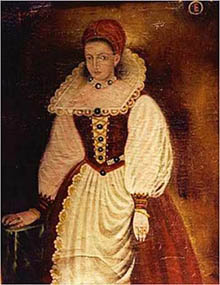

Dracula, Prince of Wallachia
DRACULA'S Family:
[formerly part of Hungary, now in Romania]
Written and researched by Margaret [nee Knight] Odrowaz-Sypniewska
The Kingdom of Wallachia was ruled by Prince Basarab, "the Great," from 1310-1352. Sfantul Nicolae Church (Saint Nicolas), founded by the Prince Basarab I around the year 1352. Despite the splintering of the family into two rival clans, some members of the House of Basarab were thought to have "Oriental origins." They continued to govern Wallachia until well after the Ottomans reduced the principality to the status of a client state. Dracula was the last prince of Wallachia to retain any real measure of independence. Basarab is thought to be an ancestor of Dracula (meaning "son of Dracul/the Dragon") a violent warlord with a reputation for torture and sadism. Prince Mircea, "the Old," reigned from 1386-1418 and is considered to be Dracula's grandfather. He married Princess Maria Tolmay, a Hungarian, who was related to the Cilli family.
Barbara Cilli married Sigmund of Luxembourg (d. 1437), son of Charles IV of Luxemburg, as his second wife. Sigmund's first wife was Mary. She was a sister of Queen Jadwiga (1383-1399) (St. Jadwiga), both being the daughters of Louis the Great of Hungary (1370-1382) of the House of Anjou. Jadwiga married Jagiello uniting Poland and Lithuania. Albert II's widow was the daughter of Sigismund (St. Sigismund). Albert II was the Duke of Austria in 1404. He was a Holy Roman Emperor on 1438 and King of Bohemia (1397-1439). He married Elizabeth (1409-1442). Her son was born on February 22, 1440, and was crowned as Ladislav V, while he was still an infant. Ladislaw V was the Duke of Austria, of Bohemia, and Hungary all in his infancy. Ladislav died on December 9, 1421. Ladislav II had a sister, Anne (1432-1462) who married William III (1425-1482), the Duke of Saxony. His sister, Elizabeth (1438-1505) married King Kazimierz IV (1427-1492)who became King of Poland in 1454. Kazimierz was the son of Jagiello, grand duke of Lithuania and King of Poland (1386-1434).
Dracula's father was Vlad Dracul (b.1395, in Wallachia). Vlad Dracul sought the support of King Ladislas II Jagiello of Poland.
*Ladislas III, son of Jagiello, became the spiritual leader of two successive crusades, and perished in battle as a knight, fighting the Turks in the company of Dracula's older brother. Vlad Dracul was murdered in December 1447. Dracula's mother was the Princess Cneajna of Moldavia. She and his father were married in 1425. Princess Cneajna was the eldest daughter of Alexandru, "the Good," Prince of Moldavia (1400-1431), a member of the Musatin family. Cneajna's brothers were Ilias and Bogdon II (father of Stephen the Great).
Dracula had an older brother named Mircea who was baptized as a Roman Catholic in 1428. Mircea was blinded with a red-hot iron stake and then buried alive in 1447. While, his younger brother, Radu, was baptized in the Orthodox Church in 1435. Dracula and Radu were held by the Ottoman Turks, as children, and had to fight off sexual advances. Apparently Radu, the youngest, eventually became one of the harem favorites. The Turks thought him very handsome and Radu was regularly sodomized by Medmed II, "the Conqueror," was the son of Murad II (1421-1451).
THE OTTOMAN EMPIRE:

|
| | | Medmud II, the Conqueror (1451-1481) | | | Bayezid II (1481-1512) | | | Selim, the Grim (512-1520) | | | Suleyman I, the Magnificent (1520-1566)
|
Radu did not leave Turkey and the Ottoman Court until 1462. He reigned from 1462-1475 as Prince of Wallachia. Radu died of syphilus and was buried in the Monastery of Tingame near Bucharest in 1500. Dracula (1431-1476) did not have a "normal" life but a life filled with pain and sorrow.
Dracula was a member of the Order of the Dragon that was founded by King Sigismund of Hungary (reigned from 1387-1437) of the House of Luxemburg, in 1410. Sigmund was the son of Charles IV Holy Roman Emperor (1346-1378), was elected King of Bohemia (1346-1378) (Germany). The Order of the Dragon was a league of Sigismund's barons. Sigismund married Mary and was King of Bohemia in 1419. King Sigismund of Hungary called a Crusade as the Ottoman Turks advanced deep into the Balkans. The battle of Nicopolis, in 1396, was a disaster, but Sigismund escaped capture. The Order of the Dragon was dedicated to the destruction of heretics and infidels. Sigismund was the brother of Wenceslas II, Duke of Luxemburg (1383-1419), King of the Romans in 1378 and Bohemia in 1400. His sister Catherine married Otto V (d. 1379). His sister Margaret married John II (d. 1420), son of Frederick V (d.1398). Janos Hunyadi was a knight. He used his own wealth to fight the Ottomans. Janos had an army of his personal followers, vassals, and family. He organized a peasant militia. In 1442, Hunyadi defeated the Turks at Sibiu, the Iron Gates, and at the Ialomita River. In 1458, the 15-year-old son of Janos Hunyadi was elected ruler of Hungary as King Matthia Corvius (1458-1490). `In 1431, the same year, his middle son, Dracula, was born in the military fortress of Sighisoara. In 1441, Dracula renewed his own pledge via Janos Hunyadi to resist the Turks. However, history tells us that Wallachia allied with the Mongol Golden Horde against Hungary, and at the same time extended its control to the Black Sea. Mircea the Old, was admired by the Turks as a courageous and shrewd Christian Prince. Wallachia held its own against Ottoman raids in 1394, 1397, 1400, and 1408. Dracul, father of Dracula, was a still a friend to the Turks, so this put him in a undesirable position. Dracul let the Turks pass through Wallachia and they then ravaged Transylvania.
| Transylvania's name came from the Latin: trans meaning "across" and silva meaning "forest." Transylvania was part of Hungary, until it became a principality of the Ottoman Empire in the 16th century. Transylvania was made a region of NW Romania [in 1918]. It was separated from the rest of the country by the Carpathian Mountains and the Transylvanian Alps. Wallachia and Transylvania are considered to be the home of vampires. The legends sprung from the blood-thirty Dracula and his niece Elizabeth Bathory, the Blood Countess, and other legends. Emily de Laszowska Gerard wrote a book called Transylvania Superstitions, in 1885. This book was said to have made Bram Stoker (1847-1912) change his anti-heroes home from Styria, Austria, to Transylvania. While writing his book, Dracula, he also read Account of the Principalities of Wallachia and Moldavia (1820) by William Wilkinson, the Consul of Bucharest. |
Janos/John Hunyadi was not amused with Dracul's soft treatment of the Turks, and he unseated Dracul from his throne, as ruler of Wallachia. Dracul (father of Dracula) sought sanctuary with the Turks. In 1443, Dracul was returned to the Wallachian throne. Dracul's sons Radu and Dracula (age 10) were then held hostages by the Turks in a castle in Anatolia, in Turkey. They two boys learned much about fear and violence under the care. Vlad Dracul organized 4,000 Wallachian soldiers under himself and his eldest son, Mircea to get even with Janos Hunyadi. When Hunyadi passed through Wallachia, Dracula had him imprisoned. Vlad the Impaler (Dracula) was the Prince of Wallachia in 1448, 1456-1462, and in 1476. Dracula married first a Transylvanian noblewoman. His second wife was Ilona Szilagy, daughter of Mihaly Szilagy,(Dracula's cousin), and a relative of Matthias Corvinus, King of Hungary. Dracula entertained a Polish nobleman (Benedict de Boithor) an ambassadors of Matthias Corvinus in his own home. Dracula was the great-uncle of Elizabeth Bathory (1560-1614). Vlad the Monk was Dracula's half-brother. Vlad the Monk married a woman named Maria and she took the veil under the name of Eupraxia. Vlad the Monk was an abbot and his religious name was Pahomie. He reigned as the Prince of Wallachia from 1482-1495. He was the son of his father's mistress Caltuna, a low born Transylvanian woman, who also became a nun and took the name Eupraxia. Vlad the Monk was thought responsible for telling Hunyadi where to find his half-brother. The in 1447, Hunyadi led an expedition against Dracul, and he and his son Mircea were killed. Vlad Dracul was beheaded. Janos Hunyadi then set himself on the throne of Wallachia. The crown next went to Vladislaw II. The Turks did not care for this turn of events, so they released Vlad Dracul's son Dracula. From this point on, Dracula was known as Vlad Tepes (meaning the impaler). Dracula was abandoned by all his people. Dracula wanted revenge for the deaths of his father and brother, so he impaled all the boyars that had turned on his father and buried his brother alive. His parents, Vlad Dracul and Cneajna, were buried in a chapel near the present Monastery of Dealul near Tirgoviste.
Vlad Tepes "the Impaler's" mind snapped and he was responsible for the impaling of thousands. Some considered him a good ruler and others thought him a madman. He was a mix of both. Crime fell under his reign of terror. People were afraid because they knew their punishment would be dealt with harshly and painfully. Impaling was a slow and agonizing death.
ELIZABETH BATHORY:
 .......
....... 
Elizabeth Bathory was nicknamed "the Blood Countess." She was born in 1560, in 1611 Elizabeth was tried for her killings, and she died in August 1614, after being held prisoner in her own castle for three years. Countess Erzebet Bathory (her baptized name) lived in Csejthe Castle in the Carpathian Mountains, near what then was Hungary. She killed about 300 women for their blood. She filled her bath with their blood to preserve her youth. Her vanity cost her village many young virgins. Elizabeth was known to have epileptic fits, while one of her uncles was a Satanist. Her brother Stephen was a drunken lecher, and her husband was said to have taught her all she knew about tortures. Elizabeth married Fereenc Nadasdy when she was only 15 years of age. Nadasdy used his dungeon for the torture of his enemies. The Count Ferencz was considered a brave soldier, turned bad. When the Count died in 1600, Elizabeth was bored and had to do some of her own torturing. Her nurse(Ilono Joo); her Steward (Johannes Ujivary); and a sorceress (Darvula) all were Elizabeth's partners in crime. They would procure her victim and bring them back to the Castle.
Erzsebet/Elizabeth Bathory's cousin, Count Gyorgy Thurso, bought soldiers and police to her castle on December 30, 1610. They found a dozen corpses in her dungeon with a large amount of puncture wounds. These wounds were apparently made to milk them of their blood. Became Elizabeth was related to the royal family, she was held captive in her own home until her death. On the other hand, all her helpers were put to death. Stephan Batory, Elizabeth's other uncle, put Dracula/Vlad Tepes, the Impaler on his Wallachian throne in 1476. Stephan was the King of Poland from 1575 until 1586. He married Anne, the daughter of Sigismund I, King of Poland from 1506 to 1548.
"It was not until the 14th century that vampirism became truly endemic, mainly in the central European regions of eastern Prussia, Silesia, and Bohemia" (Marigny).
In 1440, there was the trial of Giles de Rais (1400-1440). Gilles was thought to have had some association with vampirism. This legend was based on a book that was written by Joris-Karl Huysman. His novel La-basi portrayed Rais as a real vampire. Gilles used alchemy and thought he found the secret of the "philosopher's stone."
In 1486, Pope Innocent VIII sanctioned the publication of Malleus Malificarum, a treatise about the female (succubi) and male (incubi) noctural demons. Nachzehrer was a German term used to denote the nocturnal demons. Then King James VI (1566-1625) of Scotland jumped on the bandwagon with his book called Demonology in 1597.
WEREWOLVES:
A man called Petras Gonsalvus was called the "Wolf Man of Bavaria." He and his children had inherited disorder that caused excessive growth of hair. The portraits of him and his family were given to Bohemian King Ferdinand II (1578-1638) by his nephew William V, Duke of Bavaria. These portraits are today housed in Castle Ambras. This family was thought to have spawned the werewolf legends (of the Vrykolakas).
A man named Peter Stubbe was accused of lycanthropy and was decapitated and burned in 1589, near Cologne, Germany.
In 1725, a man named Peter Plogojowitz, a Hungarian peasant, was thought to have killed eight people in a village called Kisilova. Peter was thought to have been buried in 1725. However people claimed to have seen him walking after that.
LINKS:
more legends of the Blood Countess Elizabeta
Elizabeth Bathory
Prince Charles and Vlad Dracul
Vlad's Family Tree
SOURCES:
Florescu, Radu and Raymond T. McNally. Dracula Prince of Many Faces. Boston: Little Brown and Company (First Edition), 1989.
Gregory, Constantine. The Vampire Watcher's Handbook. New York: St, Martin's Griffin, 2003.
Marigny, John. Vampires: Restless Creatures of the Night. New York: Harry N. Abrams, Inc., 1994.
McNally, Raymond T. & Radu Florescu. In Search of Dracula. Boston: Houghton Mifflin Company, 1994.
Morby, John E. Oxford Dynasties of the World. New York: Oxford University Press, 2002.
Nicolle, David and Angus McBride. Hungary and the Fall of Eastern Europe 1000-1568. Men-At-Arms Series. London: Osprey, 1995.
Phillips, Charles. Forests of the Vampires (Slavic) Myth and Mankind Series. London: Duncan Baird Publications, 1999.
